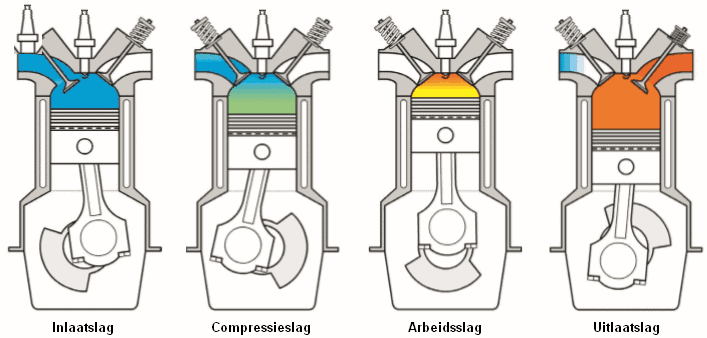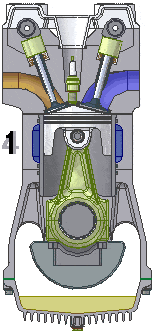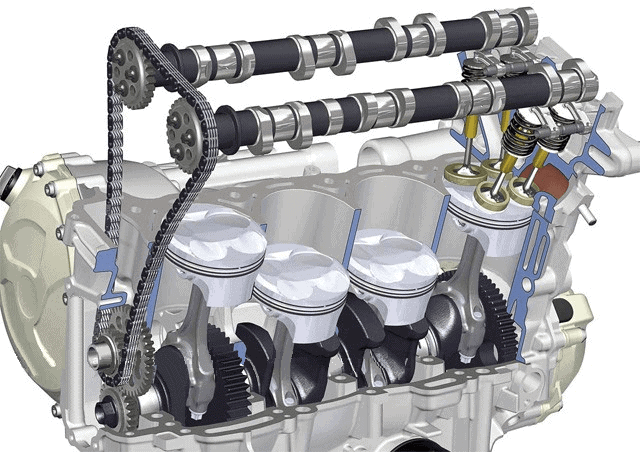Subjects:
- Operation of the four-stroke petrol engine
- Firing order (labor diagram)
- Indirect and direct injection
- Electromagnetic Injector (MPI)
- Piezo injector (DI)
- Direct Injection System Injection Strategies
- Measuring voltage and current on injectors
Operation of the four-stroke petrol engine:
The petrol engine was invented in 1876 by Nikolaus Otto and is therefore also called an “Ottomotor”. In this mixture engine, chemical energy is converted into mechanical energy. This requires air, petrol and a spark. There are various techniques to obtain as much air as possible and a controlled amount of fuel in the cylinder. With the help of variable valve timing or supercharging, a high degree of filling is achieved. The fuel injection can be realized by two different injection systems; direct and indirect injection. More on this later.
Despite all the innovative techniques, the operation of the petrol engine always comes down to the same principle. During a complete work cycle, the ignition of the gasoline results in a twisting of the crankshaft. The crankshaft is attached to the drivetrain. The different steps of the duty cycle are divided into four strokes; the intake, compression, power and exhaust stroke.

Intake Stroke: the piston moves from top dead center (TDC) to bottom dead center (ODP). The inlet valve opens simultaneously with the downward movement of the piston. The piston thus draws air into the cylinder. The air comes from the intake manifold and air filter. Depending on the type of engine, the fuel is also injected through an injector. After the piston has reached ODP, the inlet valve closes.
Compression Stroke: the intake and exhaust valves are closed and the piston moves to TDC. The mixture of air and fuel is compressed (compressed).
Labor stroke: a few degrees before the piston has reached TDC, the spark plug sparks. Because gasoline is highly explosive and there is sufficient oxygen present, combustion takes place. The force released during this process pushes the piston downwards.
exhaust stroke: after the power stroke, the piston has reached the ODP. The exhaust valve opens and the piston moves back up; the burnt gases (exhaust gas) are pushed out.
Once the piston reaches TDC, the exhaust valve closes and the intake valve opens. The valves are both slightly open in this situation; the speed at which the exhaust gases leave the cylinder has an effect on the air flowing in past the inlet valve. Air is then drawn in while the piston is not yet moving towards the ODP. This is also known as “valve overlap”.
The circle process is described on the page Seiliger process. The animation below shows the four stroke process of a gasoline engine.
The animation shows the four stroke process of only one cylinder. In automotive technology, engines are often equipped with four cylinders. Three, five, six and eight cylinders are also frequently used. Some manufacturers also use ten, twelve or even sixteen cylinders. The power strokes of the cylinders follow one another: in a four-cylinder engine, two power strokes take place for each crankshaft rotation. The order is important here; this is described in the next section.
Intake stroke (1)
Compression stroke (2)
Labor stroke (3)
exhaust stroke (4)

Firing order (labor diagram):
Engines always have a fixed firing order. With each power stroke, the combustion power is transmitted via the piston to the crankshaft. The labor force must be optimally distributed when turning the crankshaft, otherwise uneven movements may occur (i.e. extra vibrations and irregular turning).
With a four-cylinder engine (both petrol and diesel) the firing order is 1-3-4-2. This means that the power stroke first takes place at cylinder 1, half a crankshaft rotation further at cylinder 3, another half rotation further at cylinder 4 and another half rotation further at cylinder 2. The crankshaft is then rotated 2 rotations (720 degrees). There is then a complete combustion cycle.
The work diagram below shows which cylinders are working on which stroke; the moment cylinder 1 is engaged in the power stroke, the exhaust stroke takes place in cylinder 4. For information; the red arrows indicate the time of the spark plug spark.

The picture is of a four-stroke engine where the first cylinder (which is determined from the distribution side) starts its intake stroke. The piston then moves from top to bottom.
In the above work diagram it can be seen that cylinder 2 has to start the compression stroke. That is correct, because it is still in the ODP (bottom dead center). Cylinder 3 starts the exhaust stroke and cylinder 4 starts the power stroke (at this point the spark from the spark plug is created, pushing the piston downwards by the force of the ignition of the petrol-air mixture).

Related pages:
